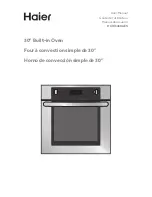
7
UK
What are microwaves?
Glass and ceramic glass
Heat-resistant glass utensils are very suitable. The
cooking process can be observed
from all sides. They must not,
however, contain any metal (e.g.
lead crystal), nor have a metallic
overlay (e.g. gold edge, cobalt blue
finish).
Ceramics
Generally very suitable. Ceramics must be glazed, since
with unglazed ceramics moisture can get into the
ceramic. Moisture causes the material to heat up and
may make it shatter. If you are not certain whether
your utensil is suitable for the microwave, carry out the
utensil suitability test.
Porcelain
Very suitable. Ensure that the porcelain does not have a
gold or silver overlay and that it does not contain any
metal.
Plastic & paper utensils
Heat resistant plastic utensils which
are suitable for use in the
microwave can be used to thaw,
heat and cook food. Follow the
manufacturers recommendations.
Heat-resistant paper made for use in a microwave oven
is also suitable. Follow the manufacturers
recommendations.
What are microwaves?
Like radio and television waves, microwaves are
electromagnetic waves.
Microwaves are produced by a magnetron inside the
microwave oven, and these vibrate the molecules of
water present in the food. The friction this causes
produces heat, which ensures that the food is
defrosted, heated, or cooked through.
The secret of the reduced cooking times is the fact that
the microwaves penetrate the food from every
direction. Energy is used to the full. In comparison, the
energy from a conventional hob passes from the
burner through the pan and so to the food. This
method wastes a great deal of energy.
The characteristics of microwaves.
Microwaves penetrate all non-metal objects made of
glass, china, earthenware, plastic, wood or paper. This is
why the microwaves never make these materials hot.
Dishes become hot only because the food inside them
is hot.
The food absorbs the microwaves and is heated.
Microwaves cannot pass through objects made of metal
and so they are deflected. For this reason metal objects
are not normally suitable for microwave cookery. There
are exceptions where you can actually make use of the
fact that the microwaves cannot pass through metal. If
you cover food with aluminium foil at specific points
while it is defrosting or cooking, you can prevent those
parts from getting too warm, too hot, or overcooked.
Please check out the advice given in the guide.
Kitchen paper
can be used to absorb any moisture which occurs in
short heating methods, e.g. of bread or products in
bread crumbs. Insert the paper between the food and
the revolving plate. The surface of the food will stay
crispy and dry. Covering greasy food with kitchen
paper will catch splashes.
Microwave cling film
This, or heat-resistant film, is very
suitable for covering or wrapping.
Please follow the manufacturer's
recommendations.
Roasting bags
Can be used in a microwave oven. Metal clips are not
suitable for fastening them since the roasting bag foil
might melt. Fasten the roasting bag with string and
pierce it several times with a fork. Non heat-resistant
food wraps are not recommended for use in a
microwave oven.
Browning dish
A special microwave dish made from ceramic glass with
a metal alloy base, which allows food to be browned.
When using the browning dish a suitable insulator, e.g.
a porcelain plate, must be placed between the turntable
and the browning dish. Be careful to adhere exactly to
the pre-heating time given in the manufacturer's
instructions. Excessive pre-heating can damage the
turntable and the turntable stand or can trigger the
safety-device which will switch off the oven.
Suitable ovenware
1. AG-31+32D-EU English 09/11/2005 09:02 Page 7
Downloaded From Microwave-Manual.com Manuals










































